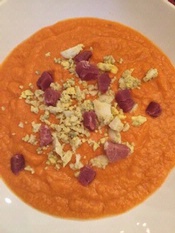WINE WITH…Salmorejo
We’ve been enjoying lots of gazpacho this season, and we bet you have too, for it seems that every restaurant now offers one version or another of

this deliciously refreshing cold soup. Based on tomatoes or even grapes, gazpacho can be red or green, or even white when it is almond-based. Gazpacho may be made smooth or chunky, thin or thick, and served with or without croutons. Salmorejo, Spain’s other delicious cold soup, adheres to a stricter code, with ingredients limited to tomatoes, olive oil, garlic, bread, salt, and sherry vinegar, plus a garnish of chopped hard-boiled egg and ham–though the ham is optional.
Thanks to the emulsification of olive oil with the tomatoes and bread, Salmorejo is thick and rich, and is a beautiful shade of orange. You may normally shrug off the idea of peeling and seeding tomatoes, but these are necessary steps in achieving Salmorojo’s smooth texture and lovely color.
Salmorejo
Serves 4
The riper and more flavorful the tomatoes are the tastier this soup will be. We like to use a blend of different tomatoes: Early Girls, Beefsteaks, and red or orange heirloom types are ideal. Larger tomatoes, which have proportionally fewer seeds and less skin, work best.
For the soup:
6-8 medium-to-large tomatoes, peeled*
2 small clove garlic cloves, crushed or finely minced
1 teaspoon sherry vinegar
1 baguette
1 cup olive oil, plus more for drizzling
½ teaspoon salt, or to taste
For the garnish:
3 hard-boiled eggs, mashed or finely chopped
About ¼ pound thickly sliced Iberico, Serrano, Prosciutto or other strong-flavored ham, diced
Cut the tomatoes in quarters. Trim off any hard cores, then scoop the seeds out and discard them. Working in batches if necessary, place the tomatoes in a blender along with the garlic, vinegar and salt.
Slice the baguette down the middle lengthwise. Using your fingers, pull all the fluffy “crumb” part of the bread away from the crust and add it to the blender. (Discard the crusts, or cut them up and freeze them for future use as croutons.)
Purée the mixture in the blender. When everything is thoroughly mixed together. remove the center of the blender’s lid and, with the motor running, slowly pour in the olive oil.
Taste for seasoning, and then refrigerate the soup for an hour or two before serving. To serve, ladle the Salmorejo into individual bowls and garnish each with egg and ham.
*The easiest way to peel tomatoes is to bring a pot of water to a boil. Using a slotted spoon, submerge each tomato in the boiling water for a mere second, then plunge it into a bowl of icy water. When you’re ready to use the tomatoes, you can pull the skins off easily with a sharp knife.
* * *
This is clearly more a white or rosé dish than a red wine one. Be careful, though, not to select a delicate white, as the soup’s rich texture and bold flavors will overpower it. Look instead for wines that have assertive characters, whether coming from their flavors, bodies, or bouquets. To our surprise, we found that a fairly light-bodied red, in this case a Pinot Noir, can work well too. But because the appeal of this wine and food partnership comes in no small measure from its refreshing personality in hot summer weather, we recommend that you serve it slightly chilled.
|
Selection
|
Approx. Price
|
Comments
|
|
Le Grand Courtâge,
France
Brut Rosé
“Grand Cuvée”
NV
(Imported by Le Grand Courtâge)
|
$18
|
Crisp and refreshing, with juicy red fruitiness, this blended fizz from various regions in France tasted simple on its own, but married well with our Salmorejo. The bubbles were what did the trick, as they provided an extra level of refreshment.
|
|
MacRostie,
Russian River Valley
(California)
Pinot Noir
2013
|
$42
|
More restrained, with earthy undertones, than most California Pinots, this wine added depth to the pairing. Again, if you choose to go the red route, put the bottle in the fridge or 30 minutes or so before you serve it.
|
|
Reyneke,
Western Cape (South Africa) Chardonnay “Vinehugger”
2014
(Imported by Vineyard Brands)
|
$17
|
A floral bouquet introduces a lively but fleshy Chardonnay that tastes of stone fruits and green apples, with nary a hint of butter or vanilla. Very refreshing, it complemented the cold soup extremely well. Do drink it this summer, though, as its virtues will only diminish with age.
|
|
Rodney Strong,
Northern Sonoma
Sonoma County
(California)
Sauvignon Blanc
“Charlotte’s Home”
2016
|
$17
|
A tad heavy when tasted on its own, this wine blossomed when drunk with the Salmorejo. Its fig and melon flavors meshed well with the sweet taste of the tomatoes. As it warmed, it lost some of its appeal, so serve it straight from the ice bucket.
|
|
Vavasour. Awatere Valley Marlborough (New Zealand) Sauvignon Blanc 2016 (Imported by Foley Family Wines)
|
$18
|
|
 this deliciously refreshing cold soup. Based on tomatoes or even grapes, gazpacho can be red or green, or even white when it is almond-based. Gazpacho may be made smooth or chunky, thin or thick, and served with or without croutons. Salmorejo, Spain’s other delicious cold soup, adheres to a stricter code, with ingredients limited to tomatoes, olive oil, garlic, bread, salt, and sherry vinegar, plus a garnish of chopped hard-boiled egg and ham–though the ham is optional.
this deliciously refreshing cold soup. Based on tomatoes or even grapes, gazpacho can be red or green, or even white when it is almond-based. Gazpacho may be made smooth or chunky, thin or thick, and served with or without croutons. Salmorejo, Spain’s other delicious cold soup, adheres to a stricter code, with ingredients limited to tomatoes, olive oil, garlic, bread, salt, and sherry vinegar, plus a garnish of chopped hard-boiled egg and ham–though the ham is optional. 